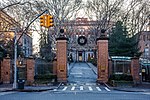Blackwell House
1796 establishments in New York (state)Houses completed in 1796Houses in ManhattanHouses on the National Register of Historic Places in ManhattanManhattan Registered Historic Place stubs ... and 3 more
Manhattan building and structure stubsNew York City Designated Landmarks in ManhattanRoosevelt Island

Blackwell House is a historic house on Roosevelt Island in New York City. The house's name comes from Jacob Blackwell, who built the house in 1796. He was the great-grandson of Robert Blackwell, who in 1686 took ownership of what was then known as Manning's Island and subsequently became the island's new namesake. The house was added to the National Register of Historic Places in 1972.
Excerpt from the Wikipedia article Blackwell House (License: CC BY-SA 3.0, Authors, Images).Blackwell House
Main Street, New York Manhattan
Geographical coordinates (GPS) Address External links Nearby Places Show on map
Geographical coordinates (GPS)
| Latitude | Longitude |
|---|---|
| N 40.760277777778 ° | E -73.951111111111 ° |
Address
Blackwell House
Main Street 500
10044 New York, Manhattan
New York, United States
Open on Google Maps








